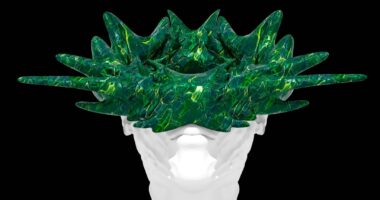Non-fungible tokens (NFTs) are unique digital assets that represent ownership or proof of authenticity of specific items or content, such as artwork, videos, music, or tweets. Unlike fungible cryptocurrencies like Bitcoin or Ethereum, NFTs cannot be exchanged on a one-to-one basis due to their unique nature. NFTs utilize blockchain technology, a decentralized and distributed digital ledger that records transactions across multiple computers.
This technology ensures each NFT’s uniqueness and prevents replication. When created, an NFT is assigned a unique digital signature, making it verifiable and tamper-proof. This signature is the source of an NFT’s value and authenticity.
NFTs can be bought, sold, and traded on various online marketplaces using cryptocurrency. The ownership and transaction history of each NFT are recorded on the blockchain, providing transparency and security for both buyers and sellers. In essence, NFTs are distinctive digital assets built on blockchain technology, ensuring their uniqueness and authenticity.
They can be traded in online marketplaces, with all transactions and ownership details securely recorded on the blockchain.
The Rise of NFT Jobs: Opportunities in the Digital Art Market
Digital Artists and Creators
One of the most in-demand roles in the NFT space is that of a digital artist or creator. With the ability to tokenize their artwork as NFTs, artists can now reach a global audience and monetize their work in ways that were previously not possible. This has opened up new revenue streams for artists and has led to the emergence of platforms specifically designed for NFT art sales.
Blockchain Development and Technology
Another growing area of opportunity in the NFT market is in blockchain development and technology. As the demand for NFT marketplaces and platforms continues to grow, there is a need for developers who can create and maintain these platforms. Additionally, there is a demand for experts in cryptocurrency and blockchain technology who can advise artists and collectors on how to navigate the NFT space.
Entrepreneurs and Emerging Opportunities
Entrepreneurs are also finding opportunities in the NFT market by creating new platforms and marketplaces specifically tailored to the buying and selling of digital assets. These platforms provide a space for artists to showcase and sell their work as NFTs, as well as for collectors to discover and purchase unique digital assets. As the NFT market continues to expand, there will likely be even more job opportunities created in areas such as marketing, legal services, and curation.
The Impact of NFTs on Artists: How NFTs Are Changing the Art Industry

NFTs have had a significant impact on artists and the art industry as a whole, offering new opportunities for monetization and exposure. One of the most notable impacts of NFTs on artists is the ability to monetize their digital artwork in ways that were previously not possible. By tokenizing their artwork as NFTs, artists can sell their work directly to collectors on online marketplaces without the need for intermediaries such as galleries or auction houses.
This has allowed artists to retain more control over their work and earn higher profits from their sales. NFTs have also provided artists with a new way to reach a global audience and gain exposure for their work. With the rise of social media and online marketplaces dedicated to NFT art sales, artists can showcase their work to a worldwide audience and connect with collectors from around the globe.
This has led to increased visibility and recognition for many artists who may have previously struggled to gain exposure in traditional art markets. Furthermore, NFTs have sparked a shift in how art is perceived and valued in the digital age. The concept of ownership and scarcity has been redefined in the digital art world, with collectors now able to own unique digital assets that are verifiable and tamper-proof.
This has led to a reevaluation of what constitutes valuable art in the digital age, with new forms of digital art gaining recognition and value in the NFT market. In summary, NFTs have had a significant impact on artists by offering new opportunities for monetization and exposure. Artists can now sell their work directly to collectors on online marketplaces without the need for intermediaries, reach a global audience, and redefine the concept of ownership and scarcity in the digital art world.
NFT News: Latest Developments and Trends in the NFT Market
| Date | Event | Impact |
|---|---|---|
| March 2021 | First NFT artwork sold for 69 million | Increased mainstream interest in NFTs |
| May 2021 | NFTs in the music industry gain traction | Artists explore new revenue streams |
| August 2021 | NFT market experiences a surge in trading volume | Increased attention from investors |
The NFT market has been rapidly evolving, with new developments and trends shaping the landscape of digital ownership and art sales. One of the latest trends in the NFT market is the integration of augmented reality (AR) and virtual reality (VR) technology into digital art. Artists are now creating interactive and immersive experiences that can be accessed through AR or VR platforms, offering collectors a new way to experience and interact with digital art.
Another notable development in the NFT market is the rise of fractionalized ownership of NFTs. This concept allows multiple investors to own a fraction of an NFT, making it more accessible for smaller investors to participate in the market. Fractionalized ownership has the potential to democratize access to high-value NFTs and create new investment opportunities for a wider range of collectors.
Additionally, there has been a growing interest in using NFTs beyond the art world, with industries such as gaming, music, fashion, and sports exploring the potential applications of non-fungible tokens. This has led to collaborations between artists, musicians, athletes, and brands to create unique digital assets that can be tokenized as NFTs and sold to collectors. In conclusion, the NFT market is constantly evolving, with new developments such as AR/VR integration, fractionalized ownership, and expansion into other industries shaping the landscape of digital ownership and art sales.
Evaluating the Value of NFTs: Factors to Consider When Investing in NFTs
When considering investing in NFTs, there are several factors to take into account to evaluate their value and potential for return on investment. One important factor to consider is the provenance and authenticity of an NFT. It is crucial to verify that an NFT is created by the original artist or creator and that its ownership history is transparent and verifiable on the blockchain.
This ensures that the NFT holds value as a unique digital asset with a clear lineage. Another factor to consider when evaluating the value of an NFT is its cultural significance and relevance within the art world. Collectors are often drawn to NFTs that have historical or cultural significance, as well as those created by well-established artists with a strong reputation in the art world.
Additionally, factors such as rarity, uniqueness, and aesthetic appeal can also influence the value of an NFT. Furthermore, it is important to consider the demand for an NFT within the market. Factors such as current trends, collector interest, and market demand can all impact the value of an NFT.
Additionally, understanding the potential for future appreciation in value based on factors such as artist reputation, historical significance, or technological innovation can help inform investment decisions. In summary, when evaluating the value of NFTs for investment purposes, it is important to consider factors such as provenance and authenticity, cultural significance, rarity, demand within the market, and potential for future appreciation in value.
NFTs and the Future of Digital Ownership: Exploring the Potential of NFTs

Verifiable Ownership in Virtual Worlds
One potential application of NFTs is in creating verifiable ownership of digital goods such as virtual real estate, in-game items, or digital collectibles within virtual worlds or metaverses. This could open up new opportunities for creators and developers within virtual environments to monetize their work through tokenization.
Protecting Intellectual Property Rights
NFTs have the potential to transform how we think about intellectual property rights in the digital age. By using blockchain technology to create verifiable ownership records for digital content such as music, videos, or written works, creators can protect their intellectual property rights and ensure fair compensation for their work. This could lead to new models for content distribution and royalties within creative industries.
Rethinking Digital Ownership
Furthermore, NFTs have implications for how we perceive ownership in a digital context. The concept of owning a unique digital asset that is verifiable on the blockchain challenges traditional notions of ownership in the digital age. This could lead to new forms of digital asset ownership and investment opportunities that were previously not possible.
In conclusion, NFTs have the potential to revolutionize how we think about digital ownership by creating verifiable ownership records for digital goods within virtual environments, transforming intellectual property rights in the digital age, and challenging traditional notions of ownership in a digital context.
NFTs and the Environment: The Environmental Impact of NFTs and Potential Solutions
The environmental impact of NFTs has been a topic of concern due to the energy consumption associated with blockchain technology. The process of minting an NFT involves complex cryptographic calculations that require significant amounts of energy, leading to carbon emissions from mining cryptocurrencies such as Ethereum. This has raised questions about the sustainability of NFTs and their long-term environmental impact.
One potential solution to mitigate the environmental impact of NFTs is through the use of alternative blockchain technologies with lower energy consumption. Some blockchain platforms are exploring more energy-efficient consensus mechanisms such as proof-of-stake or proof-of-authority, which could reduce the carbon footprint associated with minting NFTs. Additionally, there is growing interest in offsetting the carbon footprint of NFTs through initiatives such as carbon credits or renewable energy investments.
Some platforms are exploring ways to calculate and offset the carbon emissions associated with minting NFTs by investing in renewable energy projects or purchasing carbon credits to neutralize their environmental impact. Furthermore, there is an opportunity for greater transparency and accountability within the NFT market regarding its environmental impact. By providing clear information about the carbon footprint associated with minting an NFT, collectors can make more informed decisions about their purchases and support initiatives that prioritize sustainability.
In summary, addressing the environmental impact of NFTs requires exploring alternative blockchain technologies with lower energy consumption, offsetting carbon emissions through initiatives such as carbon credits or renewable energy investments, and promoting greater transparency and accountability within the NFT market regarding its environmental impact.
If you’re still unsure about the value of NFTs, you may want to check out this article on NFT-Jobs.com titled “Hello World”. The article discusses the potential of NFTs and their impact on the job market, providing valuable insights into the growing opportunities in the NFT space. It’s definitely worth a read for anyone interested in learning more about the value of NFTs and their potential impact on various industries. (source)
FAQs
What are NFTs?
NFTs, or non-fungible tokens, are digital assets that represent ownership or proof of authenticity of a unique item or piece of content, such as artwork, music, videos, or collectibles, using blockchain technology.
Are NFTs worth anything?
The value of NFTs is determined by market demand and the perceived value of the digital asset. Some NFTs have sold for significant amounts of money, while others may have little to no value.
How do NFTs gain value?
NFTs gain value based on factors such as scarcity, the reputation of the creator, the uniqueness of the digital asset, and the demand from collectors and investors.
What are the risks of investing in NFTs?
Investing in NFTs carries risks such as price volatility, lack of regulation, potential for fraud, and the uncertainty of long-term value. It’s important for investors to conduct thorough research and understand the market before investing in NFTs.
Can NFTs be traded or sold?
Yes, NFTs can be bought, sold, and traded on various online marketplaces and platforms that support the trading of digital assets. The value of NFTs can fluctuate based on market demand and other factors.





